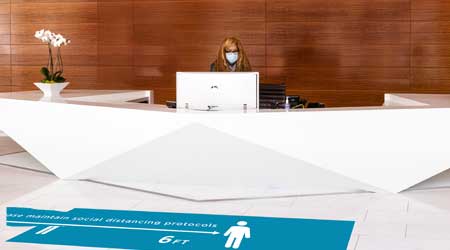 Hines
HinesHow to Focus on Occupant Experience During the Coronavirus Pandemic
Do your occupants or tenants feel safe? How do you know? In the age of coronavirus, occupant satisfaction cannot be overlooked. Indeed, it’s more important than ever.
Occupants and tenants are demanding even in the best of times. So how about now, in the worst of times? Office buildings are reopening. People are returning to work. But what is waiting for them when they arrive? Will occupants and tenants be satisfied with new coronavirus mitigation measures? Facility and property managers have the formidable task of implementing strategies that not only keep occupants and tenants safe and healthy, but also happy enough with their space that they actually want to come into the office.
The good news is that people do seem to want to come back to work, but with a few caveats. Humans are social creatures, and many are missing the interaction and teamwork the office provided. A new study by design firm Gensler showed that only 12 percent of workers would want to maintain permanent, full-time work-from-home status. And Gen X and Millennials report being more stressed and less productive working from home. So even with occupancy limits still in place in most cities and states, and new office policies to enforce social distancing, the will to return is there.
But only if it’s safe. And that’s a careful risk/reward balancing act. Even though some occupants are eager to return to the office, many are also still hesitant. In Chicago, for instance, where the local Phase 4 ordinance allows for 25 percent occupancy of office buildings, Michael Cornicelli, executive vice president of BOMA/Chicago estimates occupancy is only about 10 to 15 percent so far. As another example, in a survey of its Canadian employees, the tech company SAP found that about 90 percent weren’t comfortable returning to the office until there are COVID-19 therapies or a coronavirus vaccine.
Facility managers have their work cut out for them in terms of assuring occupants that the workplace is safe and healthy. To do that, facility managers have to know what’s working — both in terms of mitigating the threat of infection, but also in terms of what is reducing anxiety for occupants and making them feel comfortable working in their space. Even in the age of coronavirus, occupant satisfaction cannot be overlooked. Indeed, it’s more important than ever.
Now, though, occupant satisfaction means showing, telling, and being more visible and accessible than ever before. “You have to be more vigilant about what is working,” says Stormy Friday, president of the Friday Group. “It’s really important for FMs — pun intended — to be taking the temperature of people working in the building. What are they uncomfortable with? How can you make requirements more palatable?”
Because we’re still only in the early stages of this pandemic, understanding how to carefully evaluate coronavirus measures and gauge occupant and tenant satisfaction is crucial for long-term success.
Assuaging anxiety
Just because workers want to get out of their homes and return to work, assuming they believe it’ll be safe, that doesn’t mean they’re going to be totally psyched about some of the new things they’ll find there. Mask requirements, temperature checks and health surveys, and new office layouts to encourage social distancing will be daily reminders to occupants that while they’re welcome back in the office, nothing is normal anymore. So facility managers have a somewhat new role to play as office psychiatrist, helping to ease anxiety and explain why measures such as temperature checks and mandatory masks are necessary and important. “We’re expected to know the answer to everything,” says Friday. “But this gives us an opportunity to show we’re an agile component of the company.”
Take, for example, elevators. Naturally, there is going to be a bit of anxiety about hopping into a confined space with a bunch of strangers to ride to the 76th floor. That’s why facility and property managers must craft policy that both works to mitigate the spread of the virus but also assuages occupant fears.
In the case of elevators, it’s a careful balancing act with no perfect solution. A popular image that has made its way around social media shows four masked passengers facing into the corners of the elevator. The Centers for Disease Control guidelines suggest that facility managers “place decals inside the elevator to identify where passengers should stand, if needed.” These are great policies, and can certainly be effective, but only if they’re practical and doable.

(Occupants will understandably be anxious about using elevators. Clear signage showing how FMs have carefully considered elevator strategy to keep them healthy and safe can help. Credit: Hines)
For a large high-rise building, even if it’s only 50 percent occupied, it could take hours to get everyone to their destination if only a small number of people are allowed in the elevators at a time. And that means dozens of people are stuck congregating in the lobby, getting increasingly annoyed and nervous.
So what to do? The first step is to work with HR and various departments — or if a multi-tenant building, all the building’s tenants — to create staggered work schedules so that there isn’t the normal morning or evening rush hour. After that, it’s important simply to create thoughtful, but flexible policy.
Cornicelli says it’s more important to get people to their destinations quickly than to have a daily lobby mob, which is a potential super-spreader event. “Our Chicago guidelines are flexible,” he says. “People are better off being transported quickly than being jammed together in a crowd, being irritated, waiting for the next elevator.”
Explaining to occupants and tenants why a policy was put in place and its benefits for protecting their health and safety is the final step. This is true for elevators, as it is for just about every new coronavirus mitigation measure. This example shows how policy must be carefully considered, enacted, communicated, and then evaluated. Because, again, people are nervous — but the better facility managers are at connecting and explaining, the more understanding and satisfied occupants are likely to be. “When (reopening) started, everyone was freaked out, but now it’s more routine,” says Cornicelli. “Now it’s not as difficult to comply with these regulations. It’s not without inconvenience or difficulty, but it’s not as bad as everyone thought.”
Related Topics:















